|
BRITISH ISLES
Callanish
Throughout the British Isles and across the channel in Brittany, there are hundreds of stone circles that were erected thousands of years ago. Of these, the most remote stands on a ridge above Loch Roag in Scotland's Outer Hebrides. Gigantic columns of rough cut stone still give silent confirmation of mankind's understanding of the skies and its cycles. It was about 2000 BCE that the peoples of the Isle of Lewis erected a series of stone pillars and roughly arranged them in the shape of a cross circled by a ring.
The design of this site is oriented to the southern skies and centers around a five-ton megalith more than fifteen feet high and ringed by thirteen slightly shorter companion stones. According to Gerald Hawkins, these thirteen stones represent the “fundamental basis of a lunar solar calendar and could have been used for marking off the short years of twelve lunar months and the long years of thirteen lunar months. A similar system is still used in the Jewish calendar today.”
The ancient astronomers who erected Callanish would stand at the end of one of the short arms of the cross and then by sighting along that row, could see where the sun rose at the equinoxes. Callanish also marks the most northern and southern points of the moon's rising and setting in an effort to complement observations of the sun's journey between the solstices. As the moon slowly shifts towards its northern and southern most positions, it reaches a maximum position every 18.61 years.
The short line of north-south standing stones above the horizontal member of the cross aims directly at Polaris, the North Star that is the center of the sky's apparent rotation. This row is laid out with an incredible accuracy of a tenth of one degree.
It is apparent that the builders of this and other astronomical megalithic wonders were more than mere farmers. In order for these ancient peoples to mark the lunar extremes every 18.61 years, they had to have been making systematic observations over many generations.
Newgrange
The world’s oldest stone structure overlooks the Boyne River, thirty miles north of Dublin, Ireland and is one of prehistoric Europe's great archaeoastronomical wonders. In circa 3300 BCE, early Irish builders created the largest and most elaborate Neolithic tomb yet to be discovered. Facing the river, this megalithic masterpiece is a mound 30 feet high and over 260 feet in diameter. Above the entrance to the passageway is an opening between roof slabs that allows the sun at dawn on December 21st to create a subterranean light show.
This is the day of the winter solstice; a day that the sun stops its retreat from the Northern Hemisphere and winter days begin to lengthen into Spring. It marked the beginning of the end of a long cold winter and the dawning of spring’s resurrection and therefore a promise of the deceased’s own resurrections well. It is a moment in time - once a year that the dead buried within can see and be warmed by the sunlight.
In order to dispel any notion that this astronomical connection may have occurred by chance, an astrophysicist at Dublin Institute for Advanced Studies investigated this phenomenon. He concluded that the central passage was aligned with the exact moment of the winter solstice sunrise 5,150 years ago. The complexity, workmanship, and precision of Newgrange means that the Neolithic people of Ireland already had a well established understanding of the heavens and the seasons as far back as 10,000 years ago.
Stonehenge
Another world famous archaeoastronomical site is Stonehenge, a circle of giant stone megaliths which sits upon the downland of Salisbury Plain in southern England.
The question of who constructed this megalithic monument has been one of the great mysteries of prehistoric archaeology, but the reason of how and why has become more apparent in recent years. Though there are many fanciful theories surrounding the creation of Stonehenge, there are some facts that archaeoastronomers believe to be true. About 3000 BCE, Stonehenge began as a circular site defined by a huge bank with an external ditch. Holes in the ground suggest a series of large posts, or a circular timber building inside the ditch that was an earlier wooden version of the present megalithic monument.
Then, because of fire or centuries of aging, the wood was replaced sometime between 2500 and 2000 BCE by tall rectangular blue stones that were brought over 135 miles from the Preseli Mountains in southwest Wales. The two rings of giant arches were built of sandstone blocks and transported twenty-five miles south from Marlborough Downs. The largest and most massive of these are trilithons and make up the inner circle. They stand at an impressive twenty-two feet tall and weigh a massive forty-five tons each.
Scholars now believe that the builders of Stonehenge could have completed this massive structure in twenty years. If this were true, then why would a people spend so much time erecting this monument? Most likely, like other megalithic sites, it was an attempt to connect a people to the power of heaven and therefore, their gods.
It is unlikely that anyone would build such a monumental structure if they were not driven by a need to make a connection with the nature and workings of the heavens. Our ancient ancestors of the British Isles were not only building something as impressive as the heavens themselves, they were creating a gathering place for members of a tribal community. Here they would seasonally associate themselves with the clockwork of the universe and reinforce the celestial authority of the ruling chieftain.
Presumably, it is not a coincidence that Stonehenge is aligned to the rising of the summer solstice sun. It is probably not by mere chance that when the sun rises above the Heel Stone on the morning of the summer solstice it would cast a shadow touching the Altar Stone. Many believe that as the sun makes its annual passage across the sky, Stonehenge acts as a calendar, charting the passage of the seasons and accurately marking this yearly event.
According to astronomers such as Gerald Hawkins and Sir Fred Hoyle, this magnificent accomplishment of Neolithic engineering is a prehistoric observatory of solar and lunar transits. They contend that by drawing two sets of parallel lines to connect the four Station Stone sites, one could define opposing positions of the sun at the summer and winter solstices. It would also define a lunar cycle of 18.5 years. Hawkins and Hoyle conclude that Stonehenge is a Neolithic computer that is also capable of forecasting eclipses of the sun and the moon. These theories are unproven at this time.
AMERICAS
North America
Ohio Valley - Circa 200 CE
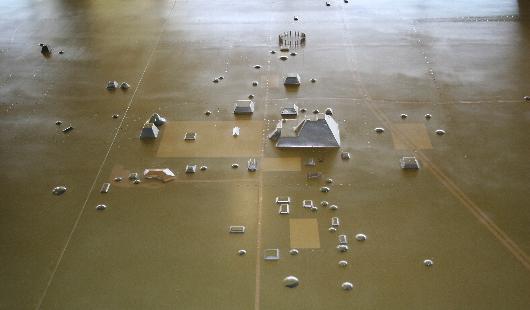 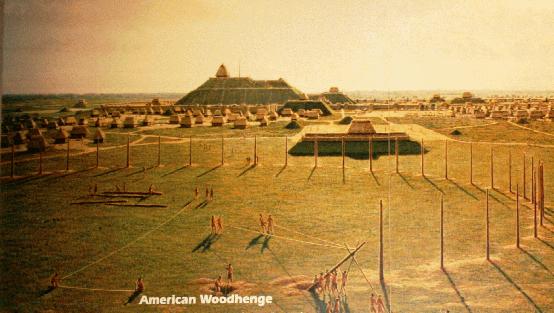 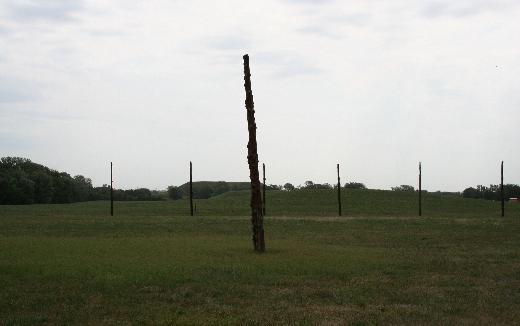
MOUNDBUILDERS
Some 3,000 years ago, the Adena people of the Ohio valley began building conical grave mounds. The tradition continued with the Hopewell people, and around 200 CE they built mounds of such precision and of such size that they are best viewed from the sky. These gigantic geometric earthworks were usually built in pairs and connected by parallel walls.In Newark, there is a typical prehistoric monument consisting of an octagon and a circle whose diameter is over 3000 feet. The method used to calculate and create such precise geometric shapes on such a large scale can be found by studying the heavens.
As the Hopewell charted the path of the moon throughout the year, they saw that it didn’t rise and set in the same place each night. They also kept track of the moon’s risings and settings that occurred at different points along the horizon over a period of 18.61 years. Eight of the rising and setting points marked the necessary lines that created coordinates for mapping out the geometric design of the Newark earthworks. Thus, the monumental creation became a lunar calendar that marked the progress of the moon and the passage of time. Once again, human beings had forged a link between the earth, the heavens and themselves.
North America
Ohio Valley - Circa 200 CE
SERPENT MOUND
.jpg) 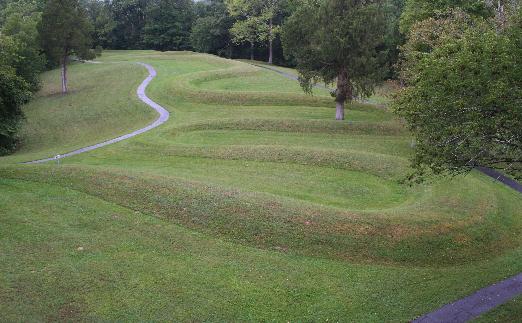 .jpg)
One of the most interesting earthworks lies next to Bush Creek, Adams County, Ohio. It is the Great Serpent mound and it is the most famous earthwork in North America and the largest serpent image in the world.
It measures 1,254 feet in length along its curves, and it was built on the edge of an inner crater, within an outer crater four miles wide that was created by the impact of a meteorite. The area contains a magnetic anomaly that was produced by the impact and to this day, a compass won’t work around the site.
The astronomical significance of this site is that it is aligned with the sun and the seasons. There is place on each coil of the serpent at which a point of celestial illumination occurred throughout the year. Each point represented the equinoxes and the solstices and the coming seasons. It has also been suggested that the seven loops of its body and tightly winding tail represent the seven stars of Ursa Minor and their annual rotation around the pole star.
North America
Southwest - Circa 850 - 1250 CE
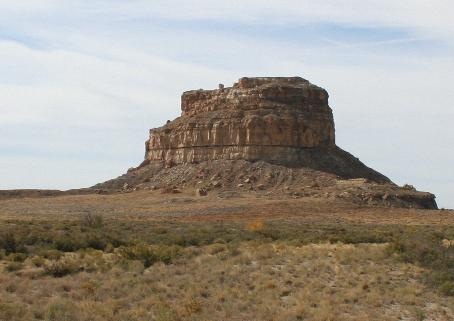 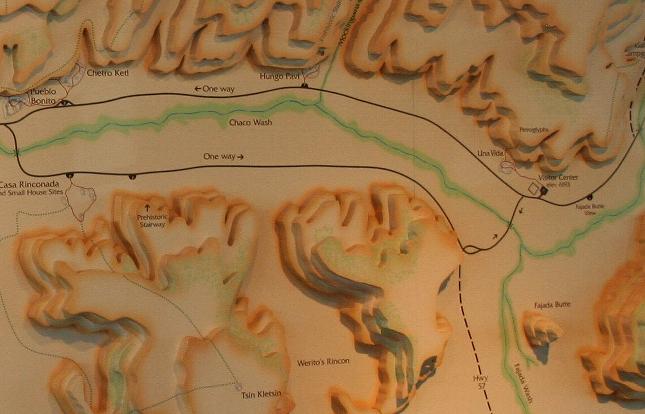
CHACO CANYON
Besides the monumental earthworks, the ancient peoples of North America created other remarkable sites such as Pueblo Bonito, in northwest New Mexico. The pueblo sits at the west end of Chaco Canyon and is a five story D-shaped complex that is accurately oriented with the cardinal directions. It is the largest prehistoric dwelling in the Southwest and once sheltered six thousand people. Within its walls sits a clan house, or kiva. It was a ceremonial house where a sunwatcher kept track of light that shined through a small slit in the wall.
The shaman would watch a ray of sunlight shine through the slot and strike a place on the wall opposite to the entry point. As the sun traveled across the sky changing positions each day, the ray of light traced the yearly path of the sun.
At the south entrance of the canyon sits another site near the top of Fajada Butte. It is there that three large slabs of rock stand upright next to a wall. On this wall is a large spiral carved into the stone. As the sun moves across the sky, a slit between the slabs of rock create a dagger of light that moves straight down the cliff wall and intersects the spiral on the summer solstice.
At the equinoxes, the dagger of light moves to the right of center. At the winter solstice, two daggers appear - one to the left of the spiral, and one to the right.
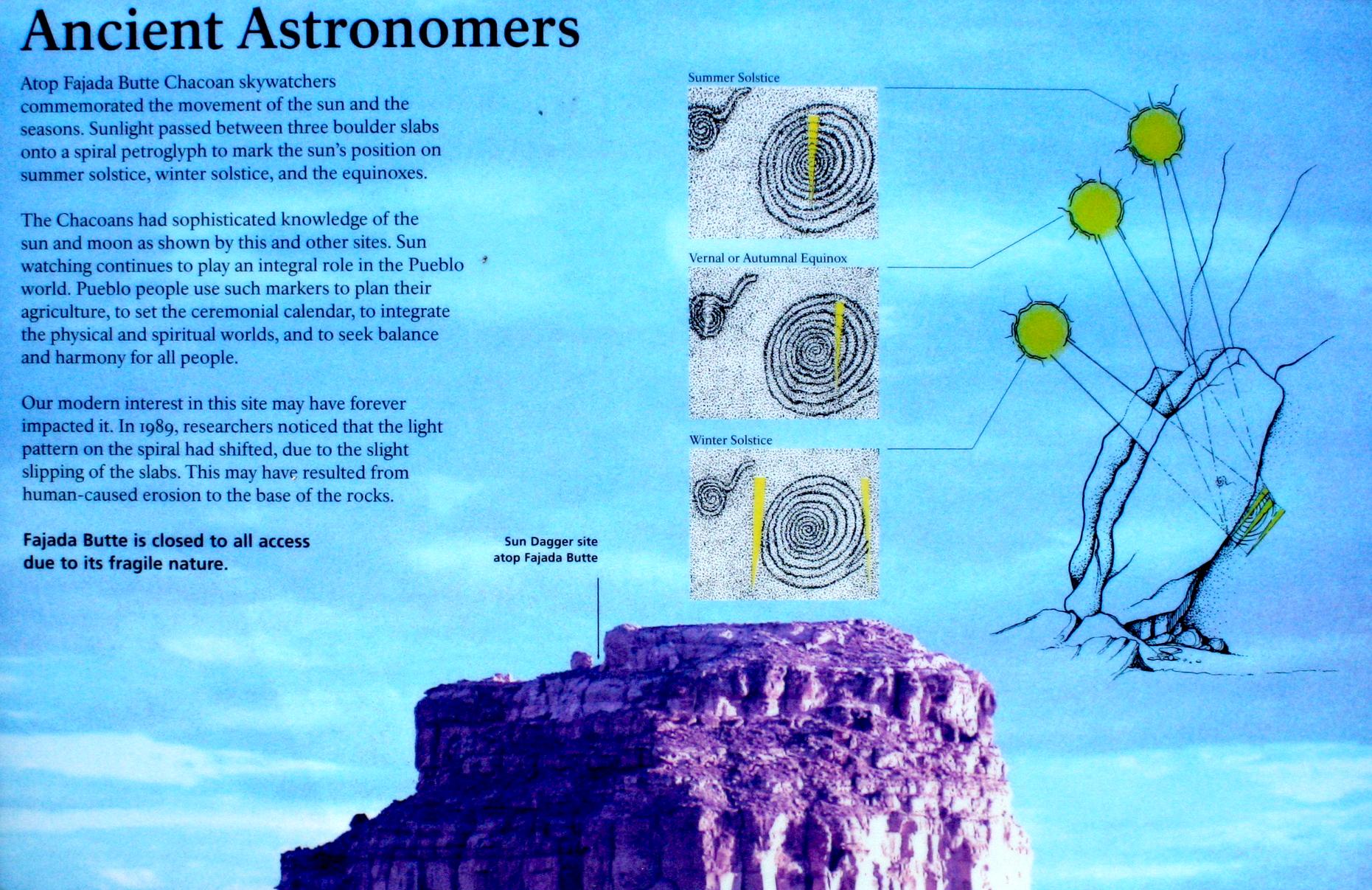
North America
Mid West - Circa 1600 CE
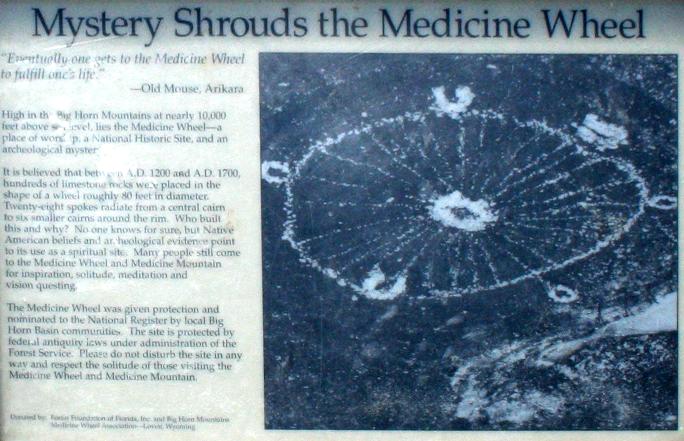 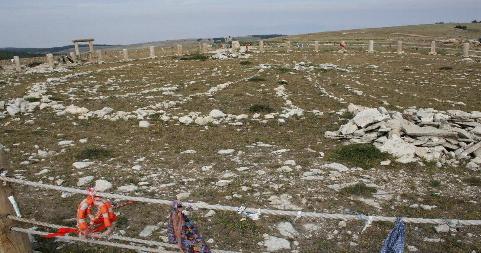 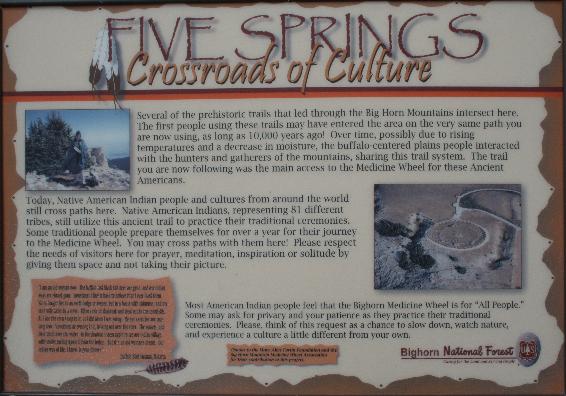
MEDICINE WHEEL
There are many medicine wheels of stone and wood, from America to Canada, designed to measure the sun’s passage and certain stars risings. One of these well-known astronomically oriented wheels is one top of Medicine Mountain in the Bighorn Mountains west of Sheridan, Wyoming. This wheel is a crude construction of sandstone fragments whose rocks are aligned to the sunrise and sunset at the summer solstice. It has been suggested that some alignments were directed at particularly bright stars at the time of its estimated construction between 1500 and 1700 CE.
Due to sever winter weather in this part of Wyoming, this site is accessible only in the summer. No matter how difficult or remote, humankind has always sought the counsel of the skies
Central America
Yucatan - Circa 1100 CE
CHICHEN ITZA
This large Toltec/Mayan pyramid combines atronomical numerology; four sides and stairways, 52 sunken panels on each side, 91 steps to stairway plus the top level for a toal of 365, and nine levels. An hour before sunset on the equinox, a light show begins as a shadow forms of the west-facing wall of the north stairway. It is a shape resembling a fire serpent. As the sun moves so does the shadow. It simulates the movement of a serpent which was a sacred animal to the people of this region.
This serpent of sunlight correlates with the legendary feathered serpents and the diamondback rattlesnakes of the traditional stories. These creatures symbolize the passage of time, seasons, and the idea of renewal.
CARACOL
Caracol is a cylindrical tower that contains windows specifically for the viewing of certain portions of the sky. Since the Maya had no telescopes to view the cycles of Venus, certain stars and constellations, they used naked eye observing and kept records of the movements in the heavens through the openings in the tower. The winter and summer solstices were also important celestial events that were tracked.
Central America
Mexico - Circa 600 CE
PYRAMID OF THE MOON
From 300 BCE to 300 CE, Mesoamerica conducted its affairs from its ceremonial and political capitol of Teotihuacan. It covers more than seven square miles and includes one of the largest known structures of early America, the Pyramid of the Sun. It was built in four steps rising on a base 689 feet square to a flat top some 210 feet high. At the northern end of the avenue is a smaller pyramid dedicated to the Moon, and at the southern end is a rectangular court enclosing a temple. All around were palace buildings, thousands of domestic structures and the population has been estimated at tens of thousands.
South America
Andes - Circa 1300 CE
MACHU PICCHU
Within the Urubamba Valley sits world famous Machu Picchu, the “Lost City” of the Inca or “Children of the Sun.” It lies on a saddle between two mountain peaks, 3000 feet above the Urubamba River, which winds around its base like a moat around a castle. This mysterious city that was constructed sometime in the fifteenth century CE and its most striking astronomical feature is the intihuatana, or “hitching post of the sun.”
It is an upright standing stone that was carved out of a single piece of gray and crystalline granite, and it is part of an altar about the size of an automobile. Many theories have been put forth in explanation of its exact purpose and function. It may have been used to cast shadows as a way to keep time and measure the daily passages of the sun throughout the year.
It may have been used in conjunction with a companion device to calculate the equinoxes and solstices. Though there were more than one of these “hitching posts,” the Spanish authorities and the clergy, during the conquest of the sixteenth century, decided that the intihuatana were of a competing religious nature and therefore had to be destroyed.
They must have never reached Machu Picchu because its “Hitching Post” never sustained the damage other sites suffered from religious persecution.
Recently, a beer company was given permission to shoot a commercial in the area and a crane fell on the hitching post and damaged it. Just shows how the Peruvian government will do anything for a little money.
There is another structure at the “Lost City” that indicates it was also used for celestial observations. It is known as the Torreon and is a rectangular building that has one wall that curves into a semicircle. It resembles the design of the “Temple of the Sun” in Cuzco. It even has an altar carved from the rock and a window that was apparently used to observe the summer solstice rising and the Pleiades open cluster. Another window could have been used to view the stars in the tail of Scorpius.
This would be important because its setting point is opposite of the rising point of the Pleiades. Even today these stars and asterisms are important to Indians near Cuzco as a means of seasonal time keeping. Machu Picchu was an important ceremonial center that connected the Inca with the heavens themselves.
AUSTRALIA
|
Glass House Mountains - Brisbane
Circa 10,000 BCE |
In Australia, tribal elders say a series of mountains near Brisbane not only play an important role in Aboriginal Astrology and culture, but are necessary in formulating a cohesive bond among the people of this southern hemisphere continent. These are the Glass House Mountains and it is said one mountain peak resembles an Aboriginal spiritual father, Baiame.
According to the storytellers, Baiame, a spirit father, was the leader of the four brothers. He lived in a cave on top of Mt. Beerwah and many natives believe that if Australia is ever going to unite as a people, they should unite with their ancestors at this place where this spirit father was known to have stayed. In this way, the ancestors are making their presence felt in this world again.
Researchers have found that this archaeoastronomical site was used as a birthing spot, and the birthing tradition recorded the star constellations directly overhead by the midwife or the second mother. She would dot out on a piece of bark their position on the night that a girl child was born. Then that bark would be kept for that baby until she came into her childbearing years. It was then explained to her that these dots on this chart represent her coming down time, when they line up in the sky exactly as they do now.
That not only indicated when her ovulation began, but would be the proof she would show to the second or third wife to indicate it was her turn to sleep with the husband to create a new generation of children. For tens of thousands of years this mountain served and a focal point for cultural identity and mythology.
Why did they choose Mt. Beerwah? It seems the sun heats the rock during the course of the day and at night time when the sun sets; the heat rises and separates the clouds directly over head.
Overcast skies would normally prevent the people from recording the stars, but this phenomenon allows observers access to the skies above that mountain 356 days of the year. The elders claim that because of the bond made between heaven and earth, not only did the people gain knowledge of aboriginal astrology, but in a sense regulated their body clocks as well. The elders say with great pride that gleaning celestial information for future generations can still be recorded there.
The Aboriginal elders strongly believe that this is just one of the many unifying elements that exist in the land down under and because of them; Australia will lead the rest of the planet in the new millennium. |












.jpg)

.jpg)





